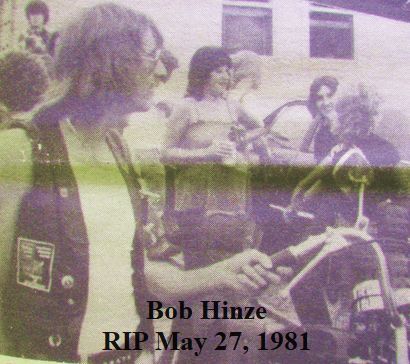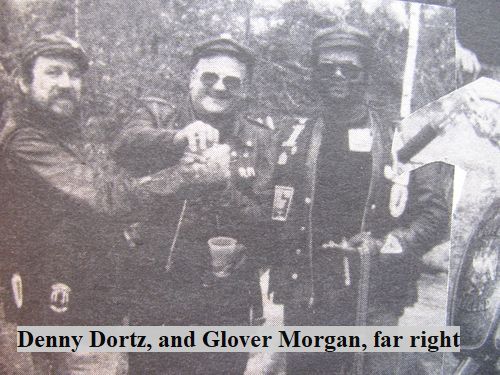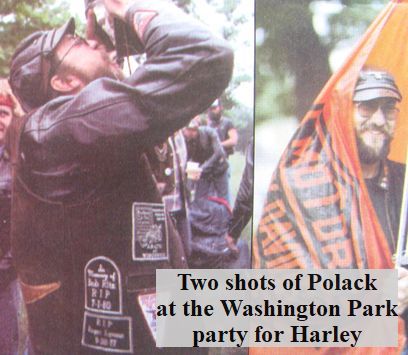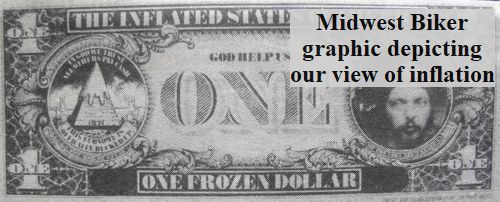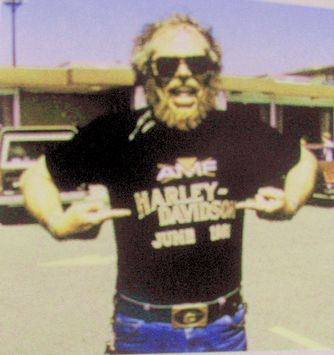In 1981, we became aware of some interesting things going on in Wisconsin as well as some nearby states. Some Vietnam Veterans who were bikers wrote to the staff of the Midwest Biker to complain about some of the things they were seeing in print about them and the war. For the first time, it seemed people were starting to show a real concern for the veterans and the injustice they faced when they returned home. Although too little, and most definitely very late, it was good to see that some people were finally welcoming them home. What upset some of these veterans in particular was the rhetoric that they were fighting for freedom. They didn’t particularly agree with that statement. Yes, they were fighting the spread of Communism in Vietnam, as it was reported by the government and media. But freedom is a word thrown around as loosely as the word brotherhood. It’s easy to use these words to promote a mindset, but the reality is they involve a complexity that most don’t understand. They are “feel good” words. What these veterans proposed is that anyone buying into the ruse that they were fighting for freedom should put on a black leather jacket, a cut-off with a patch, jump on a Harley and go for a ride in Milwaukee. Ask a biker about harassment. They claim they weren’t fighting for freedom in Vietnam, that fight is taking place in America on our streets today.
In mid-year, ABATE received a call from the Throttle Twisters MC, Milwaukee. That club was instrumental in getting the Black Coalition of clubs to participate in the Waupun Prison Show. Business Agent Tony “Pan” Sanfelipo worked with some of the Twisters at the AO Smith Corporation, and knew their boss, Phillip Hogans. The Twisters had a new clubhouse on 5th and Center Street, Milwaukee, and with the warm weather, they were hosting gatherings and barbeques at the site. Angling their bikes to the curb, it made perfect sense as a way to accommodate the dozens of visitors to their house. The police thought otherwise. Citing S.346.54 (a), “A vehicle must be parked parallel to the edge of the street, headed in the direction of traffic on the right side of the street.” (d), “In parallel parking, a vehicle shall be parked facing in the direction of traffic with the right wheels within 12 inches of the curb…”
Clearly, the statute was written for cars and trucks, since there are no “right wheels” on a motorcycle unless you have a trike or sidecar. The vagueness of the statute, regarding motorcycles, caused a great problem, and it appeared to be a way for police to harass the Twisters when entertaining guests. The police were contacted, but they weren’t budging. We saw a fight brewing, and we were up for it and for defending our friends in the Throttle Twisters, MC. Nowhere else in the state was S.346.54 being used to cite motorcyclists for parking at an angle.
Borrowing from the successful Waupun Prison Bike Show, the Alliance of Women Bikers (AWB) had its inaugural bike show in 1980, a success, and in 1981 returned to the Taycheetah Correctional Institute, Fond du Lac, for a second, larger show. Just like the men’s prison show, the bikes were judged by the residents and awarded prizes made in the prison. The Masters MC provided camping for the women riders before the show at their grounds in Ripon, Wisconsin. Saturday, June 13, a group ride formed at Rae’s Corner Bar at 11:30 AM for the ride to Taycheetah. All motorcycles and riders were subject to a search outside of the prison. Only 30 women were allowed to participate in this second show, so priority was given to AWB members. No passengers allowed on the bikes. Congratulations to Sue Menard and her members for bringing a little of our lifestyle to the women at Taycheetah.
Also in June, a celebration took place that rocked the motorcycle world. A group of men at Harley-Davidson, including Willie G., Vaughn Beals and Tim Hoelter, liberated the motorcycle company from the control of AMF. With failing sales and complaints of reliability, it was a huge risk for these men, but they saved the Harley-Davidson Motor Company from almost sure ruin and built back trust and loyalty among the many fans of the motorcycle. ABATE participated in many celebrations at the time, and hosted a special party at Washington Park in Milwaukee, which was covered in issue 100 of Easyriders Magazine. Titled “Adios, AMF,” the title had a double-intendre. A little crude, but it was how we felt at the time. Go ahead and guess.
There was so much stuff going on in Wisconsin in the 1980s that ABATE was featured in many biker magazine articles. It didn’t hurt that Tony Pan was a contributor to Easyriders, Choppers, FTW, Iron Horse, Tattoo and a few other publications. An Iron Horse issue featured an ABATE member, Bill Schertzl, and his Ariel Square Four. That same issue had a feature story, “The Farmer’s Daughter,” which was shot at a pheasant farm in Waukesha, across the road from Jingle’s house. Doc Moody and his bike were the features of that fictional photo-story, shot by Billy Tinney and Woody. Also, Degenerate Jim covered the Waupun Prison Show and the AMF takeover party at the park for FTW Magazine and Biker Lifestyle, formerly Chopper Magazine, owned by Bob Bitchin’. It seemed ABATE of Wisconsin was in just about every bike magazine (not motorcycle magazine), and we were getting national attention.
Late in the year, word came from ABATE of Michigan that the American Automobile Association (AAA) was complaining that poor automobile drivers were having to pay the medical bills and pick up the tab for emergency services for injured cyclists. What this really meant was that AAA insured car drivers were running over cyclists, and the insurance company had to pay out. Carl Richardson of ABATE of Michigan pointed out some of the ridiculous statistics AAA was using to gain support for maintaining the helmet law. According to AAA, if you rode a motorcycle, you had a one in 50 chance of dying. According to Richardson, there were 10,000,000 bikes in the U.S.A., and 15,000,000 regular riders. Using the AAA hypothesis, that means there would be 300,000 bikers killed. Spreading BS like the AAA is known as “Statistic Shock Syndrome.”
Meanwhile, since 1976 when the federal DOT’s mandate against states to enforce the mandatory helmet law was struck down by Congressional action, more than two-thirds of the states repealed their law. Louisiana was one of those early states to repeal a helmet law. That ended in September, 1981, with reinstatement of the law. The American Motorcyclist Association (AMA) contacted its members in states facing reintroduction of a helmet law, and in Louisiana it found its chartered clubs openly endorsed a helmet law, and were instrumental in its passing. Although AMA officials favored voluntary use, they always felt it was the rider’s choice, but in Louisiana, they said riders preferred the mandate. Maybe the AMA members favored the mandate, but it hardly speaks for the entire riding population of the state. Who was really responsible for the reinstatement of the helmet law in Louisiana. ABATE of Wisconsin put the blame on two groups. A small special interest group called the Safety Council of Baton Rouge put forward a strong assault on the repeal of the helmet law. They were assisted by the AAA, the AFL-CIO, the Louisiana Epilepsy Association, and the Louisiana Farm Bureau. This group relied heavily on costs to citizens due to motorcycle crashes (public burden theory). Although fraught with errors, nobody questioned the figures spewing out from the group. While this first group said a lot about public burden, more information sometimes lies in what’s not being said; namely the public burden was no greater for riders than automobile passengers, and repeal states actually had comparable or lower fatality rates that states with helmet laws.
The second group ABATE of Wisconsin blamed for the reintroduction of the helmet law in Louisiana was the state’s bikers. They did nothing to fight HB 15, the reinstatement bill. Gary Winn, Government Relations Department of the AMA, said most AMA members and the general riding community did not respond to the bill to reinstate. The Safety Council worked hard and they won, due to the apathy of the riders in Louisiana.
Finally, near the end of 1981, Wanda Hummel, State Coordinator of ABATE of Indiana, was stepping down for a well-deserved retirement. Taking her place at the helm, Mike “Balls” Farabaugh. Active in both ABATE and the AMA, he was more than qualified to take over in the tradition and manner formed by the First Lady of ABATE, Wanda Hummel. He would, of course, go on to make a huge statement for ABATE of Indiana, both in the realm of motorcyclist’s rights and safety. Although stepping down from leadership in Indiana, Wanda Hummel was not through. She, along with Balls, Jim Rhodes, Bill Gannon and a few others, moved forward to found the Motorcycle Riders Foundation (MRF), and history was made again from strong ABATE leaders who refused to surrender the vigilance needed to maintain the victories the bikers had attained and to forge a strong alliance of ABATE chapters across the country to insure those victories would not perish.


